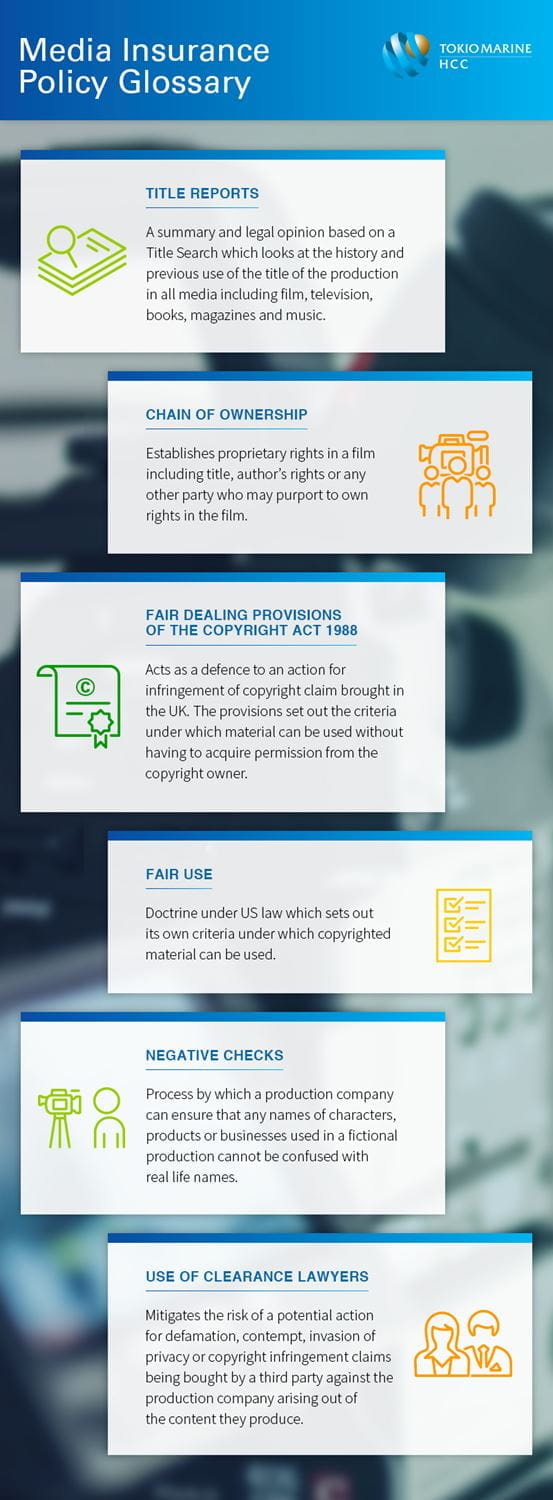Monday 24 February 2020
- Thought Leadership
The Story Behind the Story - How Films are Made
By Ros Breese, Danielle Turner and Lucy Smith
Your client has a great idea for a film, a compelling case to bring it to life and a full production plan. But have they considered all the legal issues? And are they aware of the range and levels of insurance cover they can obtain to protect them?
Failure to cover these risks could result in extremely costly consequences.
We recently co-hosted an event with specialist media law firm Wiggin which looked at the process of making a film and the myriad of issues that may arise, even with rights and permissions agreed up-front.

The story
Lewis, a producer, picks up a copy of a famous footballer’s autobiography while waiting for his flight at an airport. He is so gripped by the story that he decides to make it into a film.
He presents the idea to his friend, Janine, who agrees to co-produce the movie.
The sportsperson agrees to option the rights to the book to the production company and allows them to turn it into a film.
Lewis and Janine hire a ghost writer to work from the book creating the script for the film. Upon reading it, Janine wants to make some changes and enlists her friend Gemma to action them.
The movie is made and released to instant acclaim, exceeding all box office expectations.
But then the problems start…
Gemma feels she has not been fairly credited in the titles for her work on the script, culminating in an authorship dispute and a claim for breach of copyright.
Then, the footballer’s parents sue the production company, independently of each other. Despite Lewis obtaining their permission prior to release, the mother sues for breach of privacy as the film discloses some personal details that she had not consented to release, and the father sues for defamation as he feels the film portrays him as a bad and violent father.
The production company was advised at pre-production stage that they would not be able to film at the footballer’s own stadium, so they engaged a set designer to “recreate” it in a mocked-up version. However, the football club owns the rights to the image, look, and feel of their stadium and sues the production company for breach of copyright.
Finally, the official club and league’s logo feature in the final film and both claim unintentional breach of a license to use their trademarked material.
Where insurance provides protection
Luckily, Lewis and Janine took advice from a specialist broker. Without the right cover in place, they would be facing a hefty bill!
Liability can arise, even if one believes they have been diligent in securing all rights and permissions – like Lewis.
Specialist Film and TV Errors and Omissions (E&O) insurance was devised to protect even the most cautious production company who may find themselves exposed to a plethora of risks. Many of which are especially difficult to foresee, as described in our story.
Our policy would cover Lewis for all of the following:
Defamation or disparagement of character, reputation or feelings of any person or organisation including libel, slander, product disparagement and malicious falsehood;
Unintentional breach of confidentiality or other invasion, infringement or interference with rights of privacy or publicity including false light and the public disclosure of private facts;
Unintentional infringement of copyright, title, slogan, trademark, trade dress, service mark, misappropriation of ideas, formats, characters, trade names, character names, titles, plots, musical compositions, voices, slogans, graphic material or artwork, passing off and plagiarism or commercial appropriation of name or likeness;
Misuse of any information which is either confidential or subject to statutory restrictions;
Unintentional breach of a license to use a third party’s trademarked or copyrighted material but only to the extent that use exceeds the express limitations in the license regarding territory, duration or media in which the material may be used
Unintentional failure to give credit or attribution of authorship in accordance with any agreement to which the Insured is a bound signatory
Claims against parties having a financial interest in the production, where the insured has a legal liability;
Defence costs are inclusive to the indemnity limit.
With this in place, Lewis could be reassured that our team of experts and our bespoke policy will protect his business from the financial repercussions should any of these allegations be proven.
Understanding media policy terminology
Insurance jargon can be tricky to understand in an industry with many unique facets. We have described some of the more common of them here for you. Having them clear in your mind will help you understand and explain them better to your clients.









